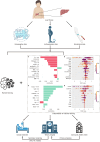Construction of a community-based primary screening and hospital-based confirmatory screening pathway in pediatric nonalcoholic fatty liver disease
- PMID: 40741471
- PMCID: PMC12305124
- DOI: 10.3748/wjg.v31.i28.108321
Construction of a community-based primary screening and hospital-based confirmatory screening pathway in pediatric nonalcoholic fatty liver disease
Abstract
Background: Fibrosis is a critical event in the progression of pediatric nonalcoholic fatty liver disease (NAFLD).
Aim: To develop less invasive models based on machine learning (ML) to predict significant fibrosis in Chinese NAFLD children.
Methods: In this cross-sectional study, 222 and 101 NAFLD children with available liver biopsy data were included in the development of screening models for tertiary hospitals and community health centers, respectively. Predictive factors were selected using least absolute shrinkage and selection operator regression and stepwise logistic regression analyses. Logistic regression (LR) and other ML models were applied to construct the prediction models.
Results: Simplified indicators of the ATS and BIU indices were constructed for tertiary hospitals and community health centers, respectively. When models based on the ATS and BIU parameter combinations were constructed, the random forest (RF) model demonstrated higher screening accuracy compared to the LR model (0.80 and 0.79 for the RF model and 0.72 and 0.77 for the LR model, respectively). Using cutoff values of 90% for sensitivity and 90% for specificity, the RF models could effectively identify and exclude NAFLD children with significant fibrosis in the internal validation set (with positive predictive values and negative prediction values exceeding 0.80), which could prevent liver biopsy in 60% and 71.4% of NAFLD children, respectively.
Conclusion: This study developed new models for predicting significant fibrosis in NAFLD children in tertiary hospitals and community health centers, which can serve as preliminary screening tools to detect the risk population in a timely manner.
Keywords: Children; Less invasive test; Machine learning; Nonalcoholic fatty liver disease; Significant fibrosis.
©The Author(s) 2025. Published by Baishideng Publishing Group Inc. All rights reserved.
Conflict of interest statement
Conflict-of-interest statement: All the authors report no relevant conflicts of interest for this article.
Figures


References
-
- Li J, Ha A, Rui F, Zou B, Yang H, Xue Q, Hu X, Xu Y, Henry L, Barakat M, Stave CD, Shi J, Wu C, Cheung R, Nguyen MH. Meta-analysis: global prevalence, trend and forecasting of non-alcoholic fatty liver disease in children and adolescents, 2000-2021. Aliment Pharmacol Ther. 2022;56:396–406. - PubMed
-
- Wang Y, Yang ZR, Chen RH. [Meta-analysis of the prevalence of non-alcoholic fatty liver disease in Chinese children] Zhongguo Ertong Baojian Zazhi. 2022;30:764–769.
-
- Hagström H, Nasr P, Ekstedt M, Hammar U, Stål P, Hultcrantz R, Kechagias S. Fibrosis stage but not NASH predicts mortality and time to development of severe liver disease in biopsy-proven NAFLD. J Hepatol. 2017;67:1265–1273. - PubMed
-
- Lefere S, Dupont E, De Guchtenaere A, Van Biervliet S, Vande Velde S, Verhelst X, Devisscher L, Van Vlierberghe H, Geerts A, De Bruyne R. Intensive Lifestyle Management Improves Steatosis and Fibrosis in Pediatric Nonalcoholic Fatty Liver Disease. Clin Gastroenterol Hepatol. 2022;20:2317–2326.e4. - PubMed
MeSH terms
LinkOut - more resources
Full Text Sources
Medical

